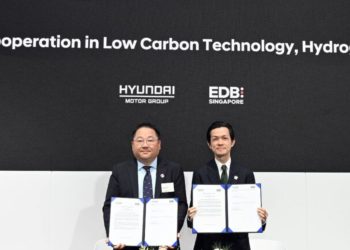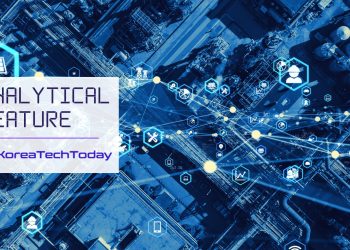Massive GPU deployment with Samsung, SK, Hyundai, and Naver aims to make Korea a key node in the global AI economy.
NVIDIA has announced a sweeping partnership with South Korea to build one of the world’s most advanced AI infrastructures — a move that strengthens both the nation’s industrial competitiveness and its technological sovereignty.
The U.S. chipmaker will supply over 260,000 of its latest GPUs to power South Korea’s sovereign AI clouds, research institutions, and corporate “AI factories.” The initiative — unveiled during the APEC Summit in Gyeongju — brings together the Korean government, public research institutes, and major conglomerates including Samsung Electronics, SK Group, Hyundai Motor Group, and Naver Cloud.
NVIDIA CEO Jensen Huang, who met with President Lee Jae Myung and top Korean executives during the summit, said the collaboration would allow South Korea to “produce intelligence as a new export.” He described the effort as a step toward transforming Korea’s manufacturing strength into digital capability.
“Korea’s leadership in technology and manufacturing positions it at the heart of the AI industrial revolution — where accelerated computing infrastructure becomes as vital as power grids and broadband,” Huang said. “Just as Korea’s physical factories have inspired the world with sophisticated ships, cars, chips and electronics, the nation can now produce intelligence as a new export that will drive global transformation.”
Building the Foundations of Sovereign AI
The partnership centers on South Korea’s Sovereign AI strategy — an effort to develop domestic infrastructure and AI models that are fully under national control.
The Ministry of Science and ICT (MSIT) will oversee the deployment of 50,000 NVIDIA GPUs for the National AI Computing Center, allowing universities, startups, and public agencies to build and train their own AI systems.
MSIT Minister Bae Kyung-hoon described the deal as a pivotal investment in national competitiveness:
“Now that AI has gone beyond mere innovation and become the foundation of future industries, South Korea stands at the threshold of transformation,” he said. “Expanding our national AI infrastructure with NVIDIA will reinforce Korea’s manufacturing capabilities and support our vision of becoming one of the world’s top three AI powerhouses.”
The new infrastructure will provide computing resources for model training, simulation, and industrial automation — accelerating progress in areas such as semiconductor design, automotive manufacturing, logistics, and robotics.
Korean Conglomerates Build Next-Generation AI Factories
South Korea’s largest corporations are taking the lead in deploying NVIDIA-powered “AI factories”, large-scale facilities designed to combine physical manufacturing with intelligent computing.
- Samsung Electronics is developing a semiconductor AI factory equipped with more than 50,000 GPUs to enhance chip design, robotics, and digital twin capabilities. Using NVIDIA Omniverse, CUDA-X, and cuLitho, Samsung will simulate chip production lines to improve efficiency and reduce waste. The company will also apply NVIDIA Isaac Sim and Isaac Lab to its home robotics program.
- SK Group plans to establish a GPU-based AI research facility with another 50,000 GPUs, advancing semiconductor R&D and industrial cloud services. Its telecom arm, SK Telecom, will provide sovereign infrastructure using NVIDIA’s RTX PRO 6000 Blackwell GPUs for domestic manufacturers and AI startups.
- Hyundai Motor Group, together with NVIDIA, will invest approximately $3 billion to expand its AI ecosystem. The two companies are co-developing AI capabilities for autonomous vehicles, smart factories, and embedded chips through new institutions like the NVIDIA AI Technology Center and Hyundai Physical AI Application Center.
- Naver Cloud will deploy over 60,000 GPUs to expand its sovereign cloud services and train Korean-language AI models using NVIDIA’s Nemotron open datasets. These models will serve industries like shipbuilding, education, and public administration.
Collectively, these projects will increase South Korea’s installed base of AI chips to more than 300,000 GPUs — nearly five times the current level — cementing its role as one of the world’s most AI-ready nations.
Integrating AI Across 6G, Telecom, and Research
The partnership extends well beyond industry. NVIDIA is collaborating with Korean universities, telecom operators, and government research institutions to push innovation in AI-RAN and 6G networks.
Working with Samsung, SK Telecom, LG Uplus, ETRI, and Yonsei University, NVIDIA is developing intelligent network architectures that use GPUs to offload computational tasks from mobile devices to network base stations. The goal is to reduce energy consumption, extend battery life, and enhance the performance of next-generation connectivity systems.
This integration of AI and telecommunications highlights Korea’s approach to ecosystem design — aligning semiconductors, cloud, and connectivity within a unified national innovation framework.
Strategic Context: AI Sovereignty and the Geopolitical Shift
The deal carries strategic significance amid growing U.S.–China technology tensions. NVIDIA has lost access to much of the Chinese market due to export restrictions, and partnerships like Korea’s help the company diversify revenue and strengthen supply chains in allied countries.
During the APEC Summit, Huang acknowledged the impact of the U.S. trade ban:
“We used to have 95% of the AI business in China — now we’re at 0%. I’m disappointed by that,” he said, adding that Korea’s “technical excellence and manufacturing strength” make it an ideal hub for global AI production.
For South Korea, the collaboration supports its ambition to secure technological independence while maintaining strong ties with both Western and Asian markets. The concept of AI sovereignty — developing domestic AI models, infrastructure, and governance frameworks — has become central to the country’s national policy.
Economic Implications: From Hardware Exports to ‘Intelligence Exports’
Analysts say that NVIDIA’s South Korean expansion is part of a global trend toward sovereign AI markets, which the company estimates could reach $1.5 trillion in value over the next decade.
By building national AI data centers and localizing model training, countries like South Korea can reduce dependence on foreign platforms and create new export categories — from specialized AI models to advanced computing services.
NVIDIA expects such sovereign AI projects to contribute more than $20 billion to its annual revenue by 2026. But for Korea, the payoff may be even larger — a transformation from a manufacturing powerhouse to a country exporting intelligence as an economic asset.
“Just as Korea’s factories once powered the world with ships, cars, and chips, they can now produce intelligence — the next great export driving the global economy,” Huang said.
Looking Ahead: Building a Sustainable AI Ecosystem
The long-term challenge lies in sustainability — ensuring that the new AI infrastructure is energy-efficient, secure, and accessible. Korea’s National AI Computing Center and corporate AI factories will require vast amounts of power, cooling, and data connectivity, prompting calls for green data center standards and expanded renewable energy capacity.
The partnership also emphasizes collaboration between academia, startups, and global tech firms. Through the NVIDIA Inception program and Korea’s N-Up AI startup initiative, early-stage companies will gain access to GPU resources and mentorship — helping to cultivate the next generation of domestic AI innovators.
If successful, South Korea could emerge as a model for how mid-sized economies build resilient, sovereign AI ecosystems — combining industrial capability, policy coordination, and public-private investment.
.







